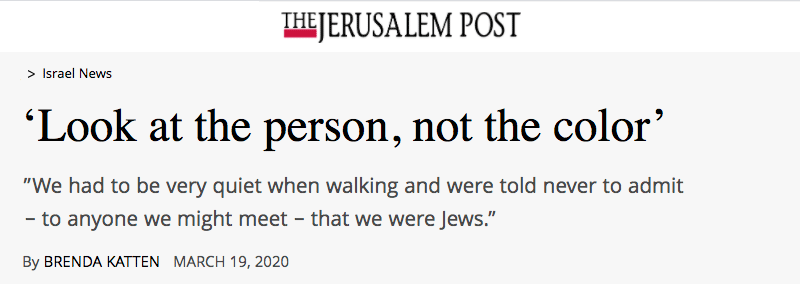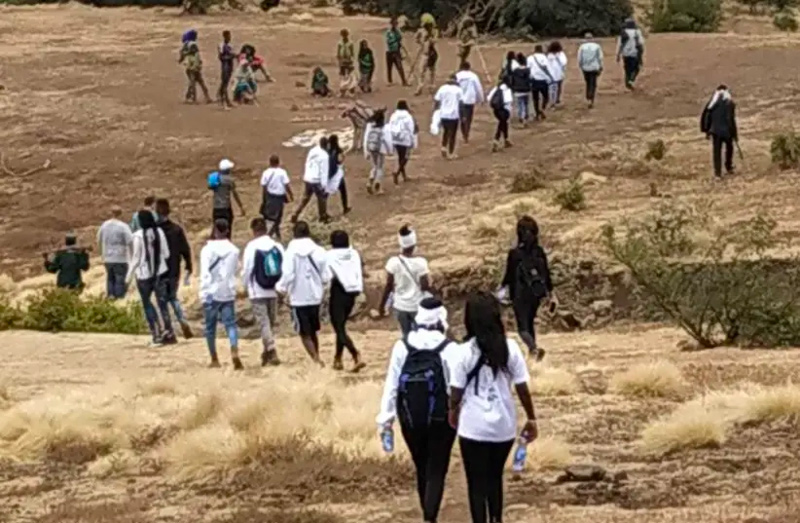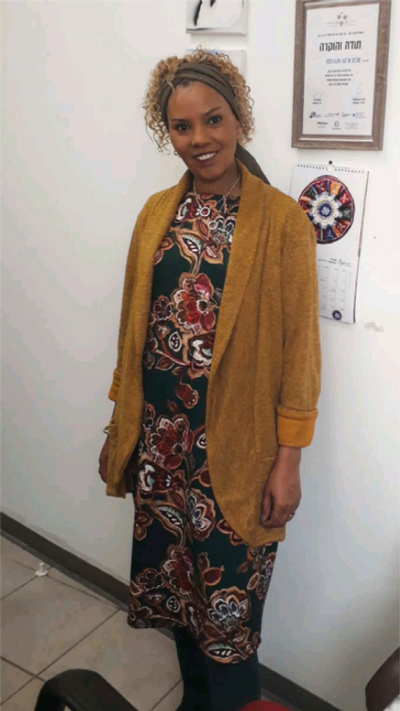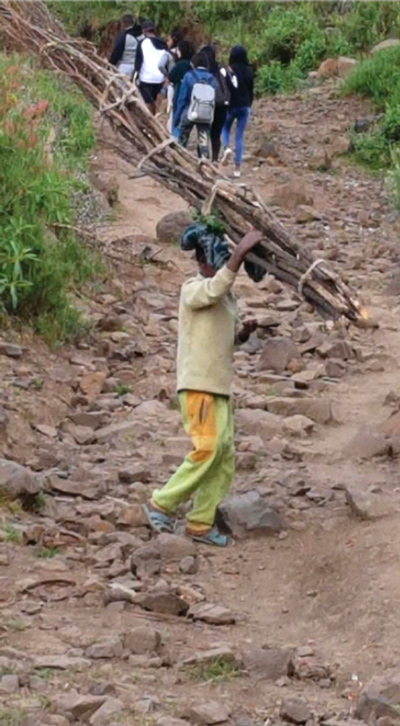

At this moment of depression covering the country – no foreseeable government and a worldwide spreading coronavirus – it was uplifting to have the opportunity to meet a very special woman who is making a difference to the lives of countless children. My colleague, Nina Zuck, ESRA’s dynamic chair of projects, introduced me to Dr. Wovit Mangisto-Worku – the Education Ministry’s national supervisor for youth at risk.

Mangisto-Worku sits in a small office surrounded by her numerous degree certificates, which in 2015, culminated in receiving her PhD. She wrote her thesis on “Ethiopian immigrant adolescents in cultural transition; ethnic identity; perceived discrimination as a precursor of school dropouts and youth at risk.” Much of her time is spent in the field. She lectures at the Hebrew University of Jerusalem and at the David Yellin College of Education.
Her students are potential school teachers and those taking their second degree in education. Mangisto-Worku impresses upon them the importance of creating change, both within themselves as well as for those they educate. As their mentor, she accentuates the need to listen and learn from their own future students. As we talked, it became clear that her success in her chosen profession reflects her own life experience.
Born in a farming village close to Gondar in Ethiopia, Mangisto-Worku was the youngest of seven children. Her father died when she was two years old. Her mother, in spite of being a single parent, took in an additional five orphans creating a family of 12 children. Initially, they all attended the local Jewish school until the day it was suddenly closed. Mangisto-Worku’s mother decided that Wovit would be the one, at the age of eight, to enter a general school, situated in the mountain region. As it was an entire day’s walk from her home, this resulted in the youngster living with an uncle who resided close by the school.
Mother’s parting words were, “Your father wanted you to be the best in whichever direction you choose.” Unfortunately, the school was not a positive experience, as she suffered antisemitism from both the Christian and Muslim pupils. Whenever something went wrong, the few Jewish pupils became the scapegoats.
Operation Moses in 1984 made the dream of coming home to Jerusalem a reality for Ethiopian Jews, whose Judaism was based solely on the written Torah, without any additional oral law. Jerusalem embraces both their conception of Judaism as a religion as well as the State of Israel. However, for all who came via Operation Moses, the physical and mental trauma of the long trek from Ethiopia to the Sudan (from where flights carried them to Israel) left an indelible scar.
Mangisto-Worku was 10 years old when she walked with her mother and four siblings to the Sudan. The other siblings were to join them later. It took two months of hard, painful trekking.
What stands out in her memory?
”We had to be very quiet when walking and were told never to admit – to anyone we might meet – that we were Jews.”
Another memory was of Shabbat, when they stopped to spend the day resting.
 Many died on the laborious walk. When the survivors were finally fortunate to reach Sudan, they were disappointed to discover that they would not be able to leave immediately for Israel. It took a further six long months of waiting before their dream became a reality. The period was fraught with challenges: no water; living in camps in dreadful weather; having to walk bare-footed on the hard soil. Every day was yet another struggle for survival.
Many died on the laborious walk. When the survivors were finally fortunate to reach Sudan, they were disappointed to discover that they would not be able to leave immediately for Israel. It took a further six long months of waiting before their dream became a reality. The period was fraught with challenges: no water; living in camps in dreadful weather; having to walk bare-footed on the hard soil. Every day was yet another struggle for survival.
Two years following the family’s arrival in Israel, Mangisto-Worku’s mother died. That was the catalyst for Mangisto-Worku to enroll as a boarder in the Yemin Orde School. There she excelled in chemistry, believing that was what she wanted to eventually study at university.
Safed was the city chosen to carry out her Sherut l’Am (National Service) as it is the place where her mother is buried. She worked there with Ethiopian youngsters who had arrived in Israel via Operation Solomon – the second airlift of Ethiopian Jews coming home to Israel. The experience made her change course as she recognized the importance of education, especially for children coming from countries that did not offer the same opportunities as Israel. Her initial aim of studying chemistry was replaced by the desire to study subjects that would enable her to help others.
“I wanted to give back that which I have received,” she said.
Mangisto-Worku’s further education consisted of a first degree in informal education followed by a second degree in education plus a teaching diploma in religious studies, all prior to her doctorate.
What is her perception of the challenges facing Israeli Ethiopians today? Priorities include narrowing the gap between children and their parents. The children speak Hebrew while many parents do not, frequently leading to the children wanting to disassociate themselves from their background. There is an urgent need to strengthen the youngsters’ sense of identity; to appreciate their roots and culture.
A successful project that addresses these needs is one started by Mangisto-Worku, together with a colleague. “Journey to Identity” is aptly named and proving to be one of ESRA’s outstandingly successful programs. Teenagers are afforded the opportunity to visit the places where their families originated; to step on the soil many of their parents and grandparents trekked for months in order to reach the Sudan; to appreciate the sacrifices their families had made so they could live a different life in Israel.
Youngsters spend nine months, prior to their Ethiopian experience, learning about their personal history as well as that of the State of Israel. They return home imbued with a sense of pride in their own roots, as well as gaining an appreciation of being able to live in the one Jewish state. More recently, the groups have included a few children from other sectors of Israeli society, providing a positive way to appreciate and understand each other.
Toward the conclusion of our conversation, Mangisto-Worku showed me two books she had written in Hebrew. One is for young Ethiopian-origin children to learn about their background. The second tells the story of her grandfather, who during the second World War helped save a town of Jews when Mussolini and his army entered Ethiopia. She gave this book to her teenage daughter who, on reading of her hero great-grandfather, decided to add his name to hers permanently.
Finally, I asked what her aims are for the future. “Education is the key to recognize the sense of loss of identity that applies to those of various backgrounds,” she replied. “The need for the teacher in the classroom to find out about her pupils; to ask them questions; to learn about their backgrounds. In this way we will give them a sense of pride in who they are and what they will be able to achieve.”
Mangisto-Worku concluded by saying, “Of the greatest significance is to look at the person and not the color.”
As I walked out of her office, deeply moved by the experience of talking to a very special individual, I wished there was a way of cloning her and her numerous attributes. For surely, Dr. Wovit Mangisto-Worku is giving back – far over and above that which she received.
The writer is public relations chairwoman of ESRA, which promotes integration into Israeli society.